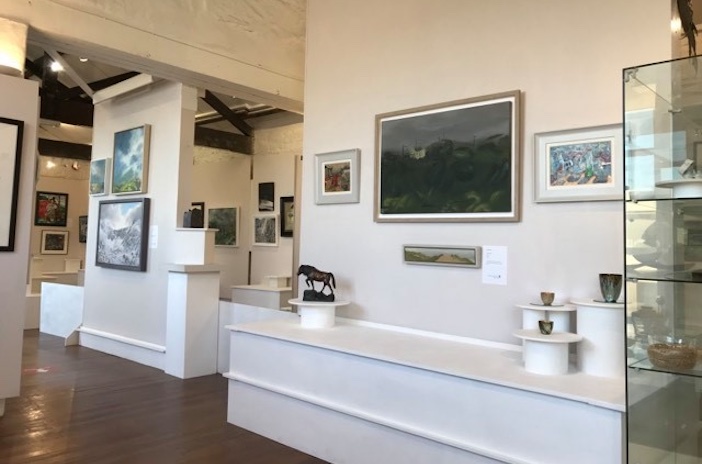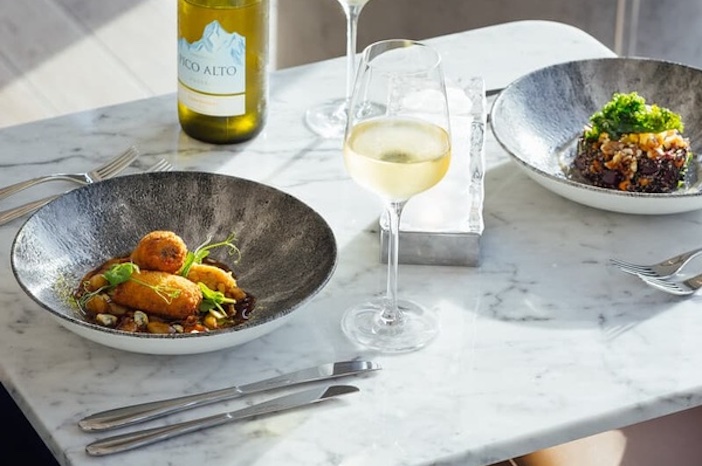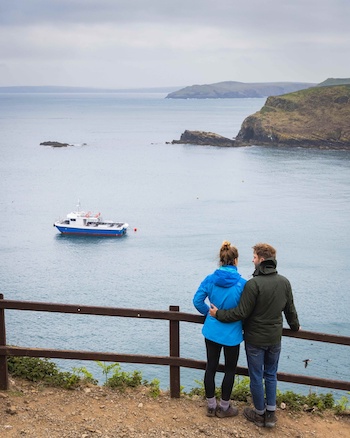The Tuckers allegedly come from South Wales, so I wasn’t surprised when I felt completely at home in Milford Haven. A stunning journey from London – discounting the full length of the M4 – it’s the fifty miles from the end of the motorway that count, concluding with views of the harbour and the fishing boats coming in, as I arrive at the Tŷ (meaning ‘home’) Milford Waterfront hotel, standing guard over the harbour.
Milford Haven skirts the Pembrokeshire Coast and is one of the fifteen national parks in the UK. While filming his series Wild Isles in 2002, Sir David Attenborough called it an area of “extraordinary complexity and wonder, fragile and beguiling”. I would concur. In the skies you can see wheaters in the spring, curlews in the autumn, small hawks in the edges and hedges in the winter and, in the summer, swallows. As well as birds, artists, poets and novelists have flocked here for inspiration – and the light, which is squint-bright. Each morning I would look out of my hotel window and see the harbour as a theatre. The skies here are big. The sunrise and sunset priceless.

That inspiration, and light, is manifest in The Waterfront Gallery, not just in art, with its regular exhibitions, but the gallery was formerly a warehouse servicing Nantucket whaling ships, and features large picture windows looking out over the harbour. And it’s this harbour area, now beautifully restored, that gives the town its unique character, and takes advantage of its position.
And it certainly is striking – Shakespeare even mentions it, in Cymbeline, in glowing terms. All the buildings have been very carefully designed to look out onto the harbour, pitching the best views for themselves. It is a place where everywhere has ‘the view’. Apart from, of course, when the fog comes as thick as pea soup, according to John from the Milford Haven Museum, and you hear the foghorn. Indeed, such is the appeal of the new-look waterfront, with its beautiful parade of shops, that it even as its own website (milfordwaterfront.co.uk) and it makes for a visitor’s paradise.

The chocolatier, Trwffl (which means truffle in Welsh) is family owned and offers Moorish-inspired chocolates made on the premises with flavours such as orange and olive oil, spiced rum, marmalade fudge and hazelnut and seasalt. Shopping is an essential part of the experience here, with other delights including the Cheeky Sheep, where the lady behind the till makes the glassware. Pure Art is a wonderful gallery with local artists and sculptors selling their wares. There are excellent cafes as well, and restaurants, with fiercely local produce.
Dulse, run by Simon Crockford, named Wales Chef of the Year in 2017, who was born and bred in Pembrokeshire, ‘went away’ as he says for twenty years to perfect his trade and has returned with his family to find the right balance of building a business in the home he loves. Dulse embodies the passion he has for incorporating seaweed into the menu, which acts as a perfect seasoning and flavouring. You do not need salt and pepper when you eat at Dulse.

Milford Haven has a fascinating history. Originally owned by Lord Hamilton (husband of ‘that’ Lady Hamilton), it was Thomas Grenville who looked after the region and helped it to prosper. Over the years it has been the home of the Vikings and Quakers (who were here for thirty years and established butchers, bakers, banking and, alas, whaling), all brought to life in the museum, housed in the Customs house, the town’s oldest building, dating back to 1797, is a Grade II listed building made of rubble stone, built originally for the storage of whale oil.
The museum tells you about the town, and its maritime history, from the earliest settlers – which were whalers – to through the different types of fishing trawlers, by sail, then steam, the propeller, through the wars and its significance to the navy. That industry is now manifest in a thriving liquid gas industry, the locals call the ‘energy cluster’, such is the impact it has not just on the skyline – the large red boats and tall towers cast a dramatic shadow, especially at twilight, but there’s a an appreciation of it, as if continuing the town’s legacy. The museum and Waterfront gallery are run by volunteers and their passion and love for the place comes across in all those you meet. They are clearly proud of their home.
 And it’s a place which makes you feel completely at home. Tourism is one of the mainstays of the economy; the national park was highlighted back in 2016 as the second-best coastal holiday destination in the world, praised for its mature and established tourism industry, which has preserved the qualities that makes the region so unique, and it’s balanced well with the rising tide of globalisation; even the imminent build of a MacDonalds barely detracts from the uniqueness of the place, and so far – MacDonalds aside – they have balanced it well. While the pandemic has changed things dramatically, with a huge explosion in visitor numbers after Covid restrictions lifted, the upsurge in people using the coastal path leave nothing but their footprints (I spotted no litter everywhere I went). I fell in love with this place.
And it’s a place which makes you feel completely at home. Tourism is one of the mainstays of the economy; the national park was highlighted back in 2016 as the second-best coastal holiday destination in the world, praised for its mature and established tourism industry, which has preserved the qualities that makes the region so unique, and it’s balanced well with the rising tide of globalisation; even the imminent build of a MacDonalds barely detracts from the uniqueness of the place, and so far – MacDonalds aside – they have balanced it well. While the pandemic has changed things dramatically, with a huge explosion in visitor numbers after Covid restrictions lifted, the upsurge in people using the coastal path leave nothing but their footprints (I spotted no litter everywhere I went). I fell in love with this place.
There are wonderful walks you are able to take, from the coastal paths to nearby Neyland. It is a place with soul, and more than just a gateway to the Pembrokeshire Coast national path, its idyllic sandy beaches, awe-inspiring views, and rugged walking trails – and some of the best wildlife spotting opportunities in Britain. (www.pembrokeshirecoast.wales).
Sarah stayed at the Tŷ Hotel, part of the Celtic Collection. For more information, including room rates and availability, please visit www.ty-hotels.com.
For information about what to do and where to eat on Milford Waterfront, visit www.milfordwaterfront.co.uk.
Images courtesy of Milford Waterfront/Tŷ Hotels




